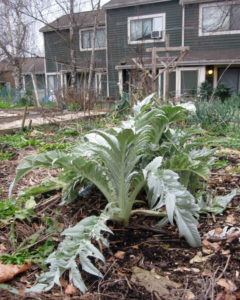What is a sustainable community? Currently, in real estate development lexicon, it is a transit-oriented project with sidewalks, bike paths, served by public transit with green/energy efficient buildings, and perhaps limited parking. But, there is a new aspect of sustainable development which integrates: Growing FOOD! Without food (and water), humans cannot survive, which is why including food production in a real estate project makes sense. Over the past 80 years, Americans have disassociated more and more with food seasonality and where our sustenance comes from and purchased food based solely on price rather than nutritional value, or on how or where it is grown.

Grapes Growing in my Yard
Growing up in Connecticut, I clearly remember the previous season’s Macintosh apples in my sack lunch and did not like its mealy April texture. With New Zealand fall-harvested apples during the northern hemisphere’s spring, the fresh crop crunch could be savored any time of the year. Grapes harvested in my yard in September are a distant memory, but right now I can have Chilean bursts of summer sweetness. Because of trends like these our food travels an average 1,500 miles from field to fork.
Since the inception of plowed agriculture, food was locally grown and families ate with the seasons, which meant eating the luscious tomatoes, corn-on-the-cob, peaches and other warm weather produce during the summer and preserving the extras into jams, jellies and relishes for the winter season. It also meant that fall-harvested crops, such as carrots, potatoes, beets, and parsnips were over-wintered in cold storage or in the ground in the Pacific Northwest to be pulled as needed. Granted winter meals were garnished with spices and treats from distant lands, but most cold weather fare included meats, grains, and root vegetables that could be stored, slaughtered or caught when summer abundance had passed.
Prairie Crossing: An Early Agricultural Community Adapter
Now forward thinking people want to take control of their food sources and know where their sustenance comes from. According to the Urban Land Institute, more than 200 developments across the nation have an agricultural twist. I visited one of the earliest examples, Prairie Crossing in Grayslake, Illinois, located about an hours drive north of Chicago in the middle of suburbia.

Prairie Crossing Homes and Plowed Farmland
Prairie Crossing is a conservation community, a model of sustainable development, which integrates preservation of natural habitat, connecting the community with trails, beach, and play areas, while incorporating an organic for-profit farm and a non-profit education farm. The Prairie Crossing property was purchased in 1987 by a group of neighbors that wanted to preserve the open space and agricultural land. Beginning in the 1990’s a community was designed and developed with 359 single family homes, 36 condominium units, a small retail center, a charter school, and a neighborhood gathering center, all adjacent to two separate railway lines into Chicago and Milwaukee. The project incorporated innovative landscaping and stormwater management systems, trails, pocket parks, and homesites on 677 acres that had been slated for a traditional 2,400 home subdivision. Entering the community on a brisk, cold, November day, I could feel the tenor of endless taillights in the neighboring sprawl development slip away.
I went to Prairie Crossing to learn about the 100-acre organic farm operation owned by Sandhill Family Farms, but came away with so much more. Mike Sands, Senior Associate of Liberty Prairie Foundation, the non-profit arm of the Prairie Crossing development graciously spent the morning with me explaining the history of how this conservation community came to be. Homes designed in keeping with the midwestern architectural tradition grace the property with swaths of open prairie separating neighborhoods, which are connected by ten miles of trails. Mike’s excitement for this real estate project is an inspiration for me to build a place that connects the community with its sustenance and creates a sense of belonging in the Pacific Northwest.
Local Seattle Communities with Agriculture

Artichoke at Burke-Gilman Gardens P-Patch Community Garden
Washington is a place where values of place, connection, and belonging can be found and nurtured. Specifically, Seattle has a robust P-Patch program, more commonly known as a community garden program, where 1,900 gardeners grow food on small plots on more than 60 locations across the city. In my neighborhood, Burke-Gilman Gardens, a small apartment complex owned by Capital Hill Housing, is home to twenty-six 100 square foot P-Patch plots. Of the multitude of P-Patches across the city some have cooperatively managed composting operations and tool sharing, but all are filled with luscious produce.
These are just a few examples of real estate projects that include food production that could be used in the Pacific Northwest to create an agricultural conservation community. My wish for 2014 is that stronger, tangible connections are made with where our food comes from, how it nourishes us, and the community that it creates.
Kathryn Gardow, P.E., is a local food advocate, land use expert and owner of Gardow Consulting, an organization dedicated to providing multidisciplinary solutions to building sustainable communities. Kathryn has expertise in project management, planning, and civil engineering, with an emphasis on creating communities that include food production. Kathryn is also on the WA Sustainable Food & Farming Network Board. Kathryn’s blog muses on ways to create a more sustainable world.


Kathryn, Great article on ULI you’ve written. You might want to take a look at our website, since we’re doing something similar in your backyard. I will also explore the rest of your website, and it’s time I renewed my old membership in Urban Land
Thanks for reconnecting Alann. I did look at your website. Curious how lot sales have been going.